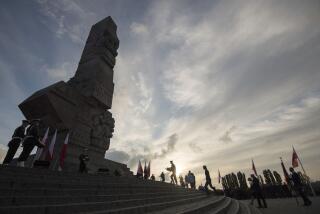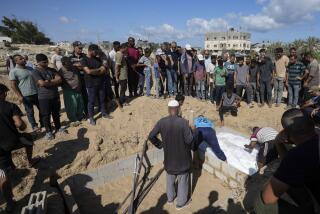A Somber Realization in Battlefields of Bones
- Share via
MOZHAYSK, Russia — The first shoots of spring grass have emerged in this sunny field, abandoned years ago when the collective farm next door shut down. Every year now, the birch and fir forest creeps a little farther into the meadow, covering its secrets with a canopy of boughs and murmuring leaves.
Every spring, when the snow has melted, the searchers come armed with shovels and spades, metal detectors and long steel probes, coaxing the field to give up its bones. This spring, they have been working for two weeks, and already there is a neat pile of ribs, thigh bones, broken skulls and bits of pelvis laid out on a plastic sheet: the remains of 94 men.
In 10 years of springs, workers have unearthed the bones of more than 2,000 other men from this field steeped in birdsong and memory. By all accounts, at least 9,000 more died here during 15 horrific days in February 1942, when Russia’s 32nd Rifle Division stood alone in the dead of winter as a tightening noose of German forces encircled, froze, starved and finally slaughtered them.
The searchers know where many of them are -- broken skeletons lie scattered on the forest floor, or piled in trenches no one has time to sift. And time is what it takes. In much of the world, the casualties of World War II lie under rows of neat white military crosses, but here in Russia, millions still lie where they fell.
A war that killed an estimated 26 million Russians -- more than 60 times the number of American casualties -- may never give up all its dead. But it won’t be because no one looked for them. For decades, teams of searchers have patiently sifted the muddy spring soil of Russia’s miserable battlefields, searching for ID tags or a name scratched on a bent spoon.
“When we started looking at the number of families who, 40 years after the war, now 60 years after the war, knew nothing about their men, I was shocked at what we discovered,” Yuri Smirnov, chairman of the Union of Search Teams of Russia, said this week as he oversaw a group of volunteers, some as young as 12.
“It turned out there are not dozens or hundreds of thousands of people missing, but millions,” Smirnov said. “It turned out that from Brest in the west to Sakhalin, the country is covered with bones. And I decided I should devote myself to looking for these people.”
So many Russians died during the nation’s fateful arrest of Hitler’s army on the eastern front that it would be impossible to ever completely record their fates. More than a million are believed to have died in Leningrad when the Third Reich army besieged the city for 30 months; a million or more were killed in the hellish battles of Stalingrad. Battlefields across thousands of square miles were littered with Russian boys whose bodies piled up as barriers to the advancing Germans.
After these battles, Germany put prisoners to work shoveling the bodies into mass graves, or Soviet commanders enlisted villagers to push them into tank trenches and bomb craters. Many were left to the thieving crows.
Smirnov and his colleagues initially tried to compile a national database of the missing soldiers. In the late 1990s, they took out newspaper ads with registration forms and painstakingly recorded the names of troops, the names of survivors, the names and locations of military units. They entered the data into a computer, and “stopped counting when we reached a million,” Smirnov said. The search teams began matching five to seven sets of bones with families per day.
But the database was lost when police, looking for evidence of trafficking in World War II-era arms, raided Smirnov’s house and office in 2000. Later, when Smirnov was cleared of any criminal wrongdoing, police refused to return the data, saying it could fall into the wrong hands.
Only once, in 1995, has the government made a small allocation for the diggings; otherwise the work is funded almost exclusively through private donations.
“Big bureaucrats tell us: ‘Why do you keep digging, boys? Who needs it? The people who needed it all died long ago.’ But we receive letters not just from wives, not just from children, but from grandchildren,” Smirnov said. “After we lost our database, a lot of our people lost their morale.”
Smirnov and his colleagues have their own explanation as to why the police confiscated the records.
Konstantin Stepanchikov, who has written several books on Russia’s war history and is a consultant to the searchers, believes that a thorough accounting could greatly inflate the government’s official estimate of 8.6 million battle deaths for the Soviet army. The higher toll, he said, would reveal the degree to which Hitler’s defeat may have been due as much to the willingness of Soviet commanders to sacrifice staggering numbers of soldiers as to their shrewdness in battle.
“One officer I know estimates the number of military losses at 14 million. And I tend to agree with him,” Stepanchikov said. Estimates of civilian casualties range from 7 million to 19 million.
Many searchers believe that the issue of compensation has been a factor in the government’s unwillingness to finance, organize or equip their excavations. Soviet-era government payments of 5 rubles a month for families with relatives killed in action could have grown by billions of dollars, according to Smirnov’s calculations.
Like the work at most of the old Soviet battlefields, the search at Mozhaysk, in the area known alternately as the Valley of Glory and the Valley of Death, is conducted in large part by young volunteers, who do three-week stints in the harsh conditions of forest and field camps.
Many of the volunteers had a grandparent who died in the war; some were sent by parents who thought a battlefield of bones would straighten out the incorrigible.
“As soon as a child comes here for the first time, he’s faced with all the weather difficulties here, the military discipline, and finally, when he excavates remains with his own hands, his thinking changes completely. He begins to grow interested in his history,” said Yevgeny Shtukaturov, who leads a Moscow-area search club working at Mozhaysk.
“My children were 16 and 12 when I first started bringing them here,” said Yelena Pavlova-Roslyakova, a Moscow police captain who was digging during her vacation. Now, years later, “my youngest son has his own military patriotic club.”
Fourteen-year-old Igor Lazarev was one of about 20 searchers who had traveled from Saratov, on the Volga River, the original home of the 32nd Rifle Division.
Most of his friends, Lazarev said, have no idea what drove him to come. “They can’t understand how digging could be interesting,” he said. “But I’m here to find the soldiers who died here. They died for us. They need to be buried.”
At night, young diggers tell of the footsteps they’ve heard out on the edge of the forest at night. Some say they know diggers who squinted into the morning fog and saw rows of men trudging into the trees.
Many said they felt a kinship with those who had died here. For others, the search means coming to terms with a long-ago war that, even now, seems an inevitable part of what it means to be Russian.
“You need to come here to do it, if only once,” said Vladimir Kharlov, a 40-year-old digger who traveled from the town of Shadrinsk, in the Urals. “You need to bring all this through your nervous system, through your heart. You need to see it with your own eyes when a grandmother after 60 years gets the documents that show what happened to her husband, how she receives it with tears in her eyes. You need to see the people who are still waiting for news.”
As best the historians can tell, the 32nd pushed ahead to Mozhaysk after fighting the Germans for weeks at the legendary battlefield of Borodino, where Russian Field Marshal Mikhail Kutuzov had confronted Napoleon’s army in 1812. Some credit the division’s efforts with holding back the Germans on the Moscow-Minsk highway long enough to save the capital.
In December 1941, Soviet troops, their backs against Moscow, launched a massive counteroffensive that helped turn the tide of the war. The 32nd pushed deep into German lines west of the city, but got so far ahead of the front that it became isolated at Mozhaysk. By February, it was nearly encircled by powerfully equipped German forces.
The men were able to get some poorly outfitted reinforcements, but in a furious exchange of mortar rounds, artillery, submachine-gun and rifle fire that lasted Feb. 6 through Feb. 20, only 10% to 20% of the 32nd’s estimated 14,000 soldiers escaped.
Working on this field for the last 10 years, searchers have been able to identify only about one in 100 of the skeletons they have recovered. The small plastic ID capsules worn by soldiers at the time are vulnerable to water and rot, and many troops refused to even wear them, convinced they were a death sentence, searchers say.
Of the 94 sets of remains uncovered this year, three had the capsules, one of which was legible. It belonged to Pavel Potilytsen, a 36-year-old soldier from the village of Bateni in the Krasnoyarsk region. His skeleton was found clutching a pair of binoculars, and the amount of shrapnel among his bones indicated he probably had been killed by a grenade.
Also partially identified were the remains of a young German soldier, who belonged to the 2nd Reserve Company of the 8th Motorized Infantry Regiment. His name wasn’t legible. He was from Berlin.
The helmets, binoculars and shrapnel are all stacked next to the bones, which are laid out neatly in rows, arm bones with arm bones, jaws with jaws, skulls with skulls. A torn boot sits to one side.
Shtukaturov surveys the grim fruits of the team’s labor. “Here the boys lie,” he says with a sigh.
On Monday, hundreds of thousands of Russians will attend military parades, fireworks displays, art shows and film festivals aimed at remembering the events of 60 years ago. Some will simply keep searching these quiet fields.
More to Read
Sign up for Essential California
The most important California stories and recommendations in your inbox every morning.
You may occasionally receive promotional content from the Los Angeles Times.










